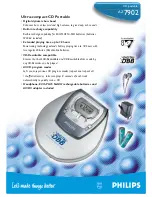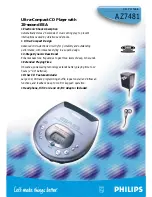
SPECIFICATIONS SUBJECT TO CHANGE WITHOUT NOTICE
3
11
12
13
15
16
17
18
19
20
21
22
23
24
14
DANGER-CARBON MONOXIDE HAZARD;
the engine exhaust contains carbon
monoxide,a poisonous odorless, invisible
gas which, if breathed, may cause death or
serious personal injury. If you start to feel sick, dizzy
or weak while using the generator, shut it off and get
to fresh air right away; you may have carbon monoxide
poisoning.
b. Good ventilation for cooling. Air flow and temperatures
are important for air cooled units. Temperatures should
not exceed 104ºF ambient (40ºC).
c. Refuel the generator in a well lighted area. Avoid fuel
spills and never refuel while the generator is running.
Allow engine to cool for two minute prior to refueling.
d. Do not refuel near open flames, pilot lights, or
sparking electrical equipment such a power tools,
welders and grinders.
e. The muffler and cleaner must be installed and kept
in good condition at all times as they function as flame
arrest if backfiring occurs.
f. Do not smoke near the generator.
Ensure that generator is properly grounded (see
Grounding the Generator section in this manual).
Do not wear loose clothing jewelry, or anything
that maybe caught in the alternator. Or other
rotating parts.
Unit must reach operating speed before electrical
loads are connected. Disconnect loads before turning
off engine.
To prevent surging that may possibly damage
equipment do not allow engine to run out of fuel when
electrical loads are applied.
When powering solid state equipment, a Power Line
conditioner should be used to prevent possible damage
to the equipment.
Do not stick anything through ventilating slots, even
when the generator is not operating. This can damage
the generator or cause personal injury.
Before transporting the generator in a vehicle, drain all
fuel to prevent leakage that may occur.
NOISE CAUTIONS
The generator can produce high noise levels. Prolonged
exposure to noise levels above 85 dBA is a hazard to
hearing. Always wear ear protection when operating or
working around the generator when it is running.
Store the generator in a well ventilated area
with the fuel tank empty. Fuel shall not be stored
near the generator.
Your generator should never be operated under these
conditions:
• Uncontrolled change in engine speed.
• Electrical output loss.
• Overheating in connected equipment.
• Sparking
• Damaged receptacles
• Engine starting failure
• Excessive vibration
• Flame or smoke.
• Enclosed compartment.
• Rain or inclement weather. Do not let the unit get wet
when operating.
Check the fuel system periodically for leaks or signs of
deteriorations, such as chafed or spongy hose, loose
or missing clamps, or damaged tank or cap. All defects
should be corrected before operation.
The generator should be operated serviced, and refueled
under the follow Conditions:
a. Start and run the generator outdoors. Do not run the
generator in an enclosed area, even if doors or windows
are open; avoid areas where vapors may be trapped,
such as pits, garages, cellars, excavations, etc.
To avoid burns, do not touch engine muffler or other
engine or generator surfaces which became hot during
operation.
Do not alter or modify the heat shield.
DEFINING TOTAL WATTAGE
1
2
3
4
5
6
7
In order to prevent overloading and possible damage to
your generator it is necessary to know total wattage
of the connected load. To determine which load and or
appliances your generator will run follow these steps.
Check wattage requirements by referring to the loads
nameplate or by calculating it (multiply amps x volts = watts).
You can get help for calculation using the Table 1
Total the watts for each item. If the nameplate only give
volts and amps, multiply volts x amps = watts. 1 kW =
1,000 watts.
Motorized appliances or tools require more than their
rated wattage for start up.
NOTE: Allow 2 ½ to 4 times the listed wattage for starting
equipment powered by electric motors.
The generator’s rated watts should match or exceed
the total number of watts required for the equipment
you want to run.
The altitude and temperature can modify the generator’s
ratings. Use the Table 2 to calculate the generator’s
rating, multiply the factor x rated output in the generator’s
specs when the condition is not at 21ºC at the sea
level.
Always connect first to the generator the heaviest load,
and then add other items one at a time.
Use proper lifting techniques when transporting the
generator from site to site. Improper lifting techniques
may result in personal injury.
PROPIEDAD EVANS.COM.MX PROPIEDAD EVANS.COM.MX PROPIEDAD EVANS.COM.MX
PROPIEDAD EVANS.COM.MX PROPIEDAD EVANS.COM.MX PROPIEDAD EVANS.COM.MX
PROPIEDAD EVANS.COM.MX PROPIEDAD EVANS.COM.MX PROPIEDAD EVANS.COM.MX
PROPIEDAD EVANS.COM.MX PROPIEDAD EVANS.COM.MX PROPIEDAD EVANS.COM.MX
PROPIEDAD EVANS.COM.MX PROPIEDAD EVANS.COM.MX PROPIEDAD EVANS.COM.MX
PROPIEDAD EVANS.COM.MX PROPIEDAD EVANS.COM.MX PROPIEDAD EVANS.COM.MX
PROPIEDAD EVANS.COM.MX PROPIEDAD EVANS.COM.MX PROPIEDAD EVANS.COM.MX
PROPIEDAD EVANS.COM.MX PROPIEDAD EVANS.COM.MX PROPIEDAD EVANS.COM.MX
PROPIEDAD EVANS.COM.MX PROPIEDAD EVANS.COM.MX PROPIEDAD EVANS.COM.MX
PROPIEDAD EVANS.COM.MX PROPIEDAD EVANS.COM.MX PROPIEDAD EVANS.COM.MX
PROPIEDAD EVANS.COM.MX PROPIEDAD EVANS.COM.MX PROPIEDAD EVANS.COM.MX
PROPIEDAD EVANS.COM.MX PROPIEDAD EVANS.COM.MX PROPIEDAD EVANS.COM.MX
PROPIEDAD EVANS.COM.MX PROPIEDAD EVANS.COM.MX PROPIEDAD EVANS.COM.MX
PROPIEDAD EVANS.COM.MX PROPIEDAD EVANS.COM.MX PROPIEDAD EVANS.COM.MX
PROPIEDAD EVANS.COM.MX PROPIEDAD EVANS.COM.MX PROPIEDAD EVANS.COM.MX
PROPIEDAD EVANS.COM.MX PROPIEDAD EVANS.COM.MX PROPIEDAD EVANS.COM.MX
PROPIEDAD EVANS.COM.MX PROPIEDAD EVANS.COM.MX PROPIEDAD EVANS.COM.MX
PROPIEDAD EVANS.COM.MX PROPIEDAD EVANS.COM.MX PROPIEDAD EVANS.COM.MX
PROPIEDAD EVANS.COM.MX PROPIEDAD EVANS.COM.MX PROPIEDAD EVANS.COM.MX
PROPIEDAD EVANS.COM.MX PROPIEDAD EVANS.COM.MX PROPIEDAD EVANS.COM.MX




































